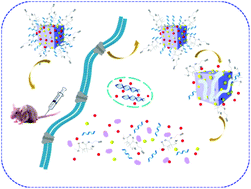A γ-cyclodextrin-based metal–organic framework embedded with graphene quantum dots and modified with PEGMA via SI-ATRP for anticancer drug delivery and therapy†
Abstract
The γ-cyclodextrin-based metal–organic framework (γ-CD-MOF) composite was designed and prepared toward targeted anticancer drug delivery and cancer therapy. Large amounts of graphene quantum dots (GQDs) were embedded in the γ-CD-MOF matrix (denoted as GQDs@γ-CD-MOF) to endow the γ-CD-MOF with strong fluorescence, which was then modified by pH responsive poly(ethyleneglycol)dimethacrylate (PEGMA) through surface initiated atom transfer radical polymerization (SI-ATRP) to fabricate the PEGMA@GQDs@γ-CD-MOF composite. Then, the cancer cell-targeted probe was obtained by immobilizing the AS1411 aptamer over it (denoted as AS1411@PEGMA@GQDs@γ-CD-MOF) and it exhibits pH-responsive release function and excellent targeting ability. Large amounts of antitumour drug, doxorubicin hydrochloride (DOX), could be encapsulated within this composite due to the chemical-rich functionality, and the resultant pH-responsive DOX delivery system (denoted as DOX/AS1411@PEGMA@GQDs@γ-CD-MOF) displayed a higher DOX loading of 89.1% with sustained release than the pristine γ-CD-MOF and GQDs@γ-CD-MOF. The targeting specificity investigation revealed that this DOX delivery system was effectively internalized via receptor mediated endocytosis with high selectivity. The in vivo antitumour study with tumour-bearing mice illustrated that the tumour growth can be effectively suppressed and partially ablated with negligible side effects after treatments. Therefore, the proposed AS1411@PEGMA@GQD@γ-CD-MOF composite is promising for effective DOX delivery and tumour growth inhibition both in vitro and in vivo, showing great potential for anticancer therapy.



 Please wait while we load your content...
Please wait while we load your content...